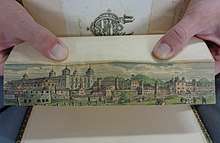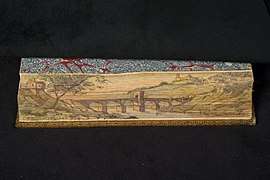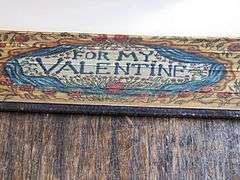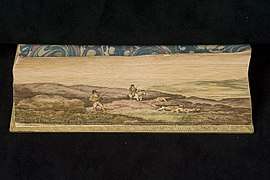Fore-edge painting

A fore-edge painting is a scene painted on the edges of the pages of a book. There are two basic forms, including paintings on edges that have been fanned and edges that are closed; thus with the first instance a book edge must be fanned to see the painting and in the second the painting is on the closed edge itself and thus should not be fanned. A fanned painting is one that is not visible when the book is closed.
In order to view the painting, the leaves of the book must be fanned, exposing the edges of the pages and thereby the painting. Another basic difference is that a painting on the closed edge is painted directly on the surface of the book edge (the fore-edge being the opposite of the spine side). For the fanned painting the watercolor is applied to the top or bottom margin (recto or verso) of the page/leaf and not to the actual "fore"-edge itself.
Variations
A single fore-edge painting includes a painting on only one side of the book page edges. Generally, gilt or marbling is applied by the bookbinder after the painting has dried, so as to make the painting completely invisible when the book is closed.
A double fore-edge painting has paintings on both sides of the page margin so that one painting is visible when the leaves are fanned one way, and the other is visible when the leaves are fanned the other way.
A triple fore-edge painting has, in addition to paintings on the edges, a third painting applied directly to the edges (in lieu of gilt or marbling). Edge paintings that are continuous scenes wrapped around more than one edge are called panoramic fore-edge painting. These are sometimes called a 'triple edge painting'.[1][2]
A split double painting has two different illustrations, one on either side of the center of the book. When the book is laid open in the center, one illustration is seen on the edges of the first half of the book, and another illustration is on the edge of the second half of the book.[3]
There are even examples of rare variations that require the pages of the book to be pinched or tented in a certain way to see the image.[3]
History
The earliest fore-edge paintings date possibly as far back as the 10th century; these earliest paintings were symbolic designs. Early English fore-edge paintings, believed to date to the 14th century, presented heraldic designs in gold and other colors. The first known example of a disappearing fore-edge painting (where the painting is not visible when the book is closed) dates from 1649. The earliest signed and dated fore-edge painting dates to 1653: a family coat of arms painted on a 1651 Bible.
There is an interesting legend of how hidden fore-edge painting on books supposedly first began: Charles II of England had a lady friend, a duchess, who often borrowed his books, sometimes forgetting to return them. As the story goes, the king commissioned the court painter, Sir Peter Lely, and the court bookbinder, Samuel Mearne, to devise a secret method in which his books could be identified. Between the two they worked out a unique plan. Some weeks later, when the king was visiting the duchess he spotted a familiar looking book on a shelf. Taking it down he said, “I’ll just take my book along with me.” “But sire,” the lady protested, “that book is mine.” “Oh?" The king raised his brows. Then, with a sly smile, he fanned out the book and revealed what had been painted on the inner edges--the royal coat of arms. The gilding on the outer edges had completely hidden the identification. Acknowledging that Charles had outwitted her, the duchess sank in a deep curtsy before her king.[4]
Around 1750, the subject matter of fore-edge paintings changed from simply decorative or heraldic designs to landscapes, portraits and religious scenes, usually painted in full color. Modern fore-edge painted scenes have a lot more variation as they can depict numerous subjects not found on earlier specimens. These include scenes that are erotic, or they might involve scenes from novels (like Jules Verne, Sherlock Holmes or Dickens, etc.). In many cases, the chosen scene will depict a subject related to the book, but in other cases it did not. In one instance, the same New Brunswick landscape was applied to both a Bible and to a collection of poetry and plays. The choice of scenes is made by either the artist, bookseller or owner, thus the variety is wide.
The technique was popularized in the 18th century by John Brindley (1732 - 1756),[5] publisher and bookbinder to the prince of Wales.[6] and Edwards of Halifax, a distinguished family of bookbinders and booksellers.[7]
The majority of extant examples of fore-edge painting date to the late 19th and early 20th centuries on reproductions of books originally published in the early 19th century.
Artists currently expert in the fore-edge artform include UK-based artists, Martin Frost and Clare Brooksbank. The reference book of L. Jeff Weber lists many artists' and binders' names associated with this art form, including those working presently (until 2010).
Collections
No comprehensive census of fore-edge paintings in the United States has yet been completed.
- College of William and Mary's Earl Gregg Swem Library holds a collection of 709 fore-edge paintings in the Ralph H. Wark Collection, the largest collection of fore-edge painted books in America.[8]
- Boston Public Library has a collection of 258 fore-edge paintings, one of the larger collections in the United States, and many examples are displayed online.[9]
- Estelle Doheny Collection housed in the Edward Laurence Doheny Memorial Library at St. John’s Seminary, Camarillo, California, is described as "roughly twice as large" as the collection at the Boston Public Library.[9]
- University of New Mexico's Center for Southwest Research & Special Collections holds 102 fore-edge paintings from the collection of Lucia von Borosini Batten of Albuquerque. Many were formerly owned by Estelle Doheny, who married her husband, oil baron Edward L. Doheny, in New Mexico Territory in 1900. Three paintings by Miss C. B. Currie are available.
- Syracuse University's Special Collections Research Center has the Poushter Collection, with more than 90 volumes.[10]
- Louisiana State University Library holds at least 37 fore-edge paintings in its Rare Book Collection. Several are probably by the artist identified by Jeff Weber as the "American City View Painter".
- Clark University holds the Robert H. Goddard Library's Rare Book Collection, which includes 17 books with fore-edge paintings.[11]
- Mudd Library at Lawrence University has a varied collection of books with fore-edge art that were donated by two alumnae, Dorothy Ross Pain Lawrence class of 1918, and Bernice Davis Fligman Milwaukee-Downer class of 1922.[12]
- Hofstra University has in their collection a few fore-edge books, some of which are Les Psaumes de David and Outlines from the Figures and Compositions upon the Greek, Roman and Etruscan Vases of the Late Sir William Hamilton.[13]

- George Peabody Library in Baltimore, Maryland also contains a collection of books with fore-edge paintings within its Dorothy McIlvain Scott Collection.
- The National Library of the Netherlands has a few fore-edge books, e.g. KW 1740 F 1 (a pendrawing and aquarelle in shades of blue, green, yellow and red,depicting a lake surrounded by mountains and on the righthand side a castle with docking place and boats) and KW 1740 F 2 (a pendrawing and aquarelle in shades of blue, green and red, depicting the Tower of London surrounded by houses and an meadow with walking people), 1786 B 24 or 1773 D 25.
Gallery
- Images from the Dorothy McIlvain Scott Collection at George Peabody Library
 Childe Harold's Pilgrimage (Lord Byron, 1812-1818)
Childe Harold's Pilgrimage (Lord Byron, 1812-1818) The New Casket (1850) by Joseph Martin Kronheim
The New Casket (1850) by Joseph Martin Kronheim Sacred Poetry (Jeremy Belknap, 1744)
Sacred Poetry (Jeremy Belknap, 1744) Rogers' Poems (Samuel Rogers, 1834)
Rogers' Poems (Samuel Rogers, 1834) Sports and Pastimes of the People of England (Joseph Strutt, 1801)
Sports and Pastimes of the People of England (Joseph Strutt, 1801)
References
- ↑ Bromer, Anne C. "Fore Edge Painting - An Introduction". On the Edge: The Hidden Art of Fore-Edge Book Painting. Boston Public Library. Retrieved 18 March 2013.
- ↑ Frost, Martin. "What Is A Fore-Edge Painting?". On the Edge: The Hidden Art of Fore-Edge Book Painting. Boston Public Library. Retrieved 18 March 2013.
- 1 2 "Lovely Hidden Paintings Adorned the Edges of Historic Books". Atlas Obscura. 2016-09-29. Retrieved 2017-10-19.
- ↑ Dutter, Vera, E. "The Ancient Art of Fore-Edge Painting", American Artist, January 1969. Retrieved on 3 March 2018
- ↑ Carter, John; Barker, Nicolas (2010). ABC For Book Collectors. New Castle, DE: Oak Knoll Books. p. 108. ISBN 9781584561125.
- ↑ "John Brindley". The British Museum. Retrieved February 29, 2016.
- ↑ "Etherington & Roberts. Dictionary--Edwards of Halifax". cool.conservation-us.org. Retrieved 2016-02-29.
- ↑ "Ralph H. Wark Collection". WM.edu. Earl Gregg Swem Library, College of William and Mary. Retrieved 10 September 2013.
- 1 2 Figenbaum, Muriel C. "The Albert H. Wiggin Collection". On the Edge: The Hidden Art of Fore-Edge Book Painting. Boston Public Library. Retrieved 18 March 2013.
- ↑ Weber, Jeff (Fall 1992). "Fore-edge Paintings at Syracuse University". The Courier. Syracuse University. Retrieved 6 May 2016.
- ↑ "Archives and Special Collections: Fore-edge Paintings". clarku.edu. Clark University. Retrieved August 29, 2017.
- ↑ "Fore-edge Paintings". lawrence.edu. Lawrence University. December 16, 2013. Retrieved August 29, 2017.
- ↑ Stramiello, Jennie. "Fore-Edge Paintings" (PDF). Hofstra.edu. Hofstra University. Retrieved August 29, 2017.
Further reading
- Gilbert, Jon, Fore-edge Painting within The New Bookbinder Volume 17, Designer Bookbinder Publications Ltd, 1997.
- Hobson, Kenneth. “On Fore-Edge Painting of Books”. In The Folio. 1949.
- Weber, Carl Jefferson. A Thousand and One Fore-edge Paintings. Waterville, Colby College Press, 1949.
- Weber, Carl Jefferson. Fore-edge painting: a historical survey of a curious art in book decoration, Harvey House, 1966.
- Weber, Jeff. Annotated Dictionary of Fore-edge Painting Artists & Binders [and] The Fore-edge Paintings of Miss C. B. Currie with a catalogue raisonné. Los Angeles, 2010.
External links
| Wikimedia Commons has media related to Fore-edge paintings. |
- Fore edge video includes video examples
- Fore-edge painting from boingboing.net
- More Fore-edge painting from boingboing.net
- Fore-edge painting from Stanford University
- Fore-edge painting, including pictures from ibooknet
- Fore-edge paintings from the Boston Public Library
- Grand Valley State University fore-edge paintings digital collections
- The Bentley Rare Book Gallery, Kennesaw State University includes video examples
- George Peabody Library Collection of Fore-edge Paintings & Decorated Bindings
- http://www.clarebrooksbank.co.uk/index.php/category/1-foredge
- Fore-Edge File: Books with paintings on the fore-edge, (44 titles dispersed in the division's collection). From the Rare Book and Special Collections Division at the Library of Congress
- https://collation.folger.edu/2012/04/fore-edge-paintings/
- https://www.atlasobscura.com/articles/lovely-hidden-paintings-adorned-the-edges-of-historic-books